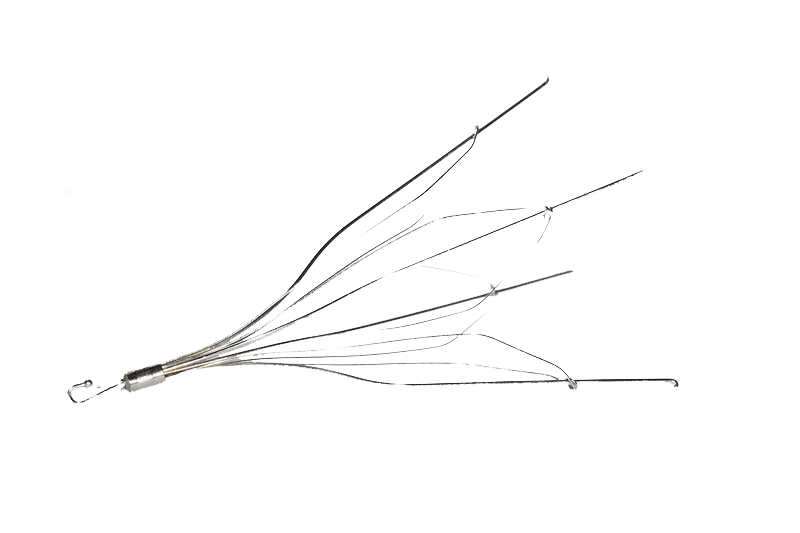Last Updated November 6, 2020
The Inferior Vena Cava (IVC) is the largest vein in the human body and is located toward the anterior of the abdomen to the right of the aorta. The IVC has one function – to carry copious amounts of deoxygenated blood back from the lower extremities of the body and back to the heart. It is an essential part of human anatomy and is a central component of the human cardiopulmonary system.
Alongside the important role that it plays in maintaining life, the IVC can also develop issues that threaten life as well. Veins like the IVC can develop clumps of thickened blood which form clots. When clots form below the heart, and in particular in the thigh or lower leg, they are referred to as “Deep Vein Thrombosis” (DVT). If a DVT clot breaks free and makes its way back to the heart or lungs, it can become a deadly “Pulmonary Embolism” (PE). Once lodged in the chest cavity, a PE can block the flow of blood to the heart and lungs, significantly disrupting cardiopulmonary function.
Symptoms of Pulmonary Embolism
Symptoms of PE can vary dramatically from patient to patient. The size of the clot and its location in the lungs, as well as the underlying heart condition of the patient, can all play a large impact on the magnitude and duration of symptoms. Common signs of PE include:
- Shortness of Breath
- Chest Pain
- Coughing
- Rapid or Irregular Heartbeat
- Lightheadedness or Dizziness
- Excessive Sweating
- Fever
- Leg Pain or Swelling
- Clammy or Discolored Skin
PE can be life-threatening. If you experience unexplained shortness of breath, chest pain, or a cough that produces bloody fluid – you should seek immediate medical attention.
Inferior Vena Cava Filters
IVC filters are small mechanical devices that surgeons place into the vein in order to prevent DVT and other types of blood clots from using the IVC as a highway back to the heart and lungs. They are spindly devices that look and act like a sifter – allowing clear blood components to pass through it while intercepting and catching clots.
IVC filters are generally recommended for patients who suffer from chronic DVT and who cannot take blood-thinning medication. Sometimes, an IVC filter will be recommended to patients who are about to undergo surgery and have to suspend taking blood thinners temporarily.
To implant an IVC filter, a physician or surgeon will make a small incision in either the groin or neck and then position the filter using a small catheter maneuvered through the incision. Once in place, the filter is “triggered” to expand and attach itself to the walls of the vein. Some IVF filters are permanently left in the vein while others are implanted with the understanding they will be removed later.
Issues with IVC Filters
IVC filters are not necessarily “new” technology. They were first cleared for use by the U.S. Food and Drug Administration (FDA) through the abbreviated 510(k) Clearance process in the late 1970s. However, their use expanded dramatically in a very short span of time between 1999 and 2008.
In 2010, the FDA, after noticing a spike of “adverse event reports” through the previous years, issued a warning about IVC filters and the potential for such issues as filter migration; embolization; perforation of the Vena Cava; and mechanical fracturing of the filter itself. The FDA’s warning was followed in 2014 with a “safety communication” concerning the filters and the agency instituted a new postmarket surveillance study to evaluate the growing use of IVC filters and to make additional recommendations.
IVC Filters and Migration
Experts have grown concerned that too many retrievable (temporary) IVC filters have been implanted into patients – and then never removed. IVC filters which are inserted on a temporary basis, but then left for a longer duration in the body can begin to shift inside of the vein. This is known as IVC filter migration – and it is a serious problem. There are three main types of IVC filter migration:
- Mechanical: Typically, this involves the failure of the device itself. Surgeons will usually identify mechanical issues during surgical implantation.
- Iatrogenic: Each IVC filter is measured and approved to fit specific measurements within the IVC itself. Iatrogenic migration occurs where the device doesn’t fit the placement properly due to guide wire entanglement.
- Physiological: Bending, coughing, or straining while lifting could cause an IVC filter to dislodge and migrate.
Embolization (Migration into Heart and Lungs)
If the IVC filter migrates far enough away and into the functioning apparatus of the heart and lungs in the chest cavity, it can create life-threatening conditions that require urgent medical treatment.
Perforation of the Inferior Vena Cava
An implanted IVC filter is designed to attach and grapple onto the walls of the vein to remain in place. However, this same technique can sometimes also result in a tiny perforation of the vein causing damage to the IVC itself as well as to surrounding tissue and organs. Symptoms of a perforated IVC include:
- Swelling
- Pain
- Pulmonary Embolism Symptoms (see above)
Some patients suffering from a perforated IVC also report progressively worsening abdominal or back pain over several weeks, later accompanied by bouts of nausea and vomiting. In any event, IVC implantees suffering from these symptoms should seek immediate medical attention and the care of a physician.
Filter Fracturing
When viewed in their operational position, IVC filters tend to resemble umbrellas in their design and function. Like an umbrella, the spindly legs which open inside of the vein are key to its function and to keep the filter in place. Some filters were designed to be implanted and stay in the body permanently. Others were designed to be implanted and then removed at a later date. Unfortunately, for patients with these “temporary” filters, the follow-up procedure to remove them is often forgotten or disregarded.
Temporary IVC filters that are left in the body can begin to degrade due to excessive wear and tear from the pressures exerted within the vascular system of the human body. Eventually, the spindly legs on the filter can break off or fracture – traveling through the body. Remember – all blood in the IVC travels toward the heart and lungs. Accordingly, a fractured filter can present a multitude of dire medical consequences for the patient including DVT, heart attacks, and internal bleeding.
The FDA and IVC Filters
To date, the FDA has yet to issue any formal recalls for any IVC filter device. Nonetheless, between 2005 and 2019, at least eight types of IVF filters have been voluntarily withdrawn from the market by their manufacturers. In its first warning letter concerning IVC filters in 2010, the FDA detailed over 921 injuries from IVC filters spanning: migration through the body; migration into the heart and lungs (embolization); perforation of the vena cava; and filter fracturing. Since 2014, filter manufacturers have been given the option of either participating in the FDA’s 522 Postmarket Surveillance Studies program or an independent clinical study known as “Predicting the Safety and Effectiveness of Inferior Vena Cava Filters” (PRESERVE).
Furthermore, filter manufacturer C.R. Bard was recently party to a now-settled case in multidistrict litigation over its filter products (MDL-2641). Cook Medical is currently a party to ongoing multidistrict litigation in federal court in Indiana (MDL-2570) over its IVC filter products.
Sources Cited (22):
1. “Complications of inferior vena cava filters” https://www.ncbi.nlm.nih.gov/pmc/articles/PMC5220210/
2. “Inferior Vena Cava Filter Migration to the Right Ventricle Causing Nonsustained Ventricular Tachycardia” https://www.ncbi.nlm.nih.gov/pmc/articles/PMC3709234/
3. “Vena cava filter ensnarement and delayed migration: An unusual series of cases” https://www.sciencedirect.com/science/article/pii/S0741521497701022
4. “Long-term complications of inferior vena cava filters” https://www.jvsvenous.org/article/S2213-333X(16)30148-2/pdf
5. “Outcomes of patients requiring insertion of an inferior vena cava filter: A retrospective observational study” https://www.researchgate.net/figure/Technical-or-mechanical-complications-related-to-IVC-filter-insertion_tbl2_259720080
6. “Iatrogenic Diversion of Inferior Vena Cava into Left Atrium after Surgery for a Rare Combination of Congenital Heart Diseases” https://www.ncbi.nlm.nih.gov/pmc/articles/PMC5027167/
7. “Iatrogenic diversion of IVC to left atrium after surgical closure of ASD” https://www.ncbi.nlm.nih.gov/pmc/articles/PMC3327021/
8. “Iatrogenic diversion of inferior vena cava to left atrium—A rare complication of surgical ASD repair” https://www.sciencedirect.com/science/article/pii/S2468600X18300021
9. “Endovascular Repair of Iatrogenic Inferior Vena Cava Stenosis in a Live Kidney Donor” https://www.vasculardiseasemanagement.com/content/endovascular-repair-iatrogenic-inferior-vena-cava-stenosis-live-kidney-donor
10. “Who should receive inferior vena cava filters?” https://acphospitalist.org/archives/2016/08/inferior-vena-cava-filters.htm
11. “Intracardiac embolization of inferior vena cava filter associated with right atrium perforation and cardiac tamponade” https://www.ncbi.nlm.nih.gov/pmc/articles/PMC4389464/
12. “Embolization of Inferior Vena Cava Filter Tyne and Right Ventricular Perforation: A Cardiac Missile” https://pubmed.ncbi.nlm.nih.gov/27847069/
13. “Perforation of Inferior Vena Cava by Inferior Vena Cava Filter” https://www.ncbi.nlm.nih.gov/pmc/articles/PMC3628471/
14. “Symptomatic inferior vena cava perforation by a retrievable filter: Report of two cases and a literature review” https://www.ncbi.nlm.nih.gov/pmc/articles/PMC2903035/
15. “Symptomatic perforation of a retrievable inferior vena cava filter after a dwell time of 5 years” https://www.sciencedirect.com/science/article/pii/S0741521409006089
16. “A fractured inferior vena cava filter strut migrating to the left pulmonary artery” https://www.ncbi.nlm.nih.gov/pmc/articles/PMC4681885/
17. “Extravascular Migration of a Fractured Inferior Vena Cava Filter Strut” https://www.ncbi.nlm.nih.gov/pmc/articles/PMC5460973/
18. “Management of Fractured Inferior Vena Cava Filters: Outcomes by Fragment Location” https://pubs.rsna.org/doi/full/10.1148/radiol.2017162005
19. “Inferior Vena Cava Filter–Associated Abnormalities: MDCT Findings” https://www.ajronline.org/doi/10.2214/AJR.11.7664
20. “Inferior vena cava” https://www.kenhub.com/en/library/anatomy/inferior-vena-cava
21. “The Anatomy of the Inferior Vena Cava” https://www.verywellhealth.com/inferior-vena-cava-anatomy-4688365
22. “Pulmonary embolism” https://www.mayoclinic.org/diseases-conditions/pulmonary-embolism/symptoms-causes/syc-20354647#:~:text=Pulmonary%20embolism%20is%20a%20blockage,body%20(deep%20vein%20thrombosis).



